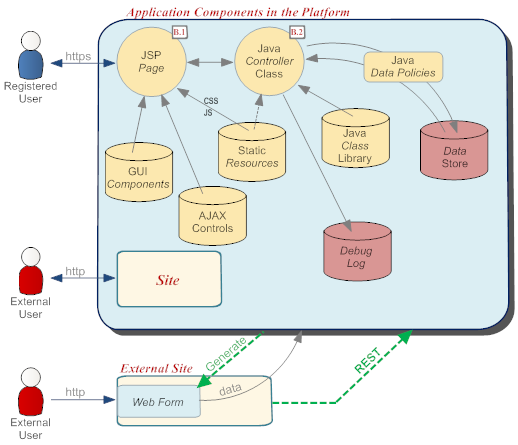Difference between revisions of "Application Architecture"
From LongJump Support Wiki
imported>Aeric |
imported>Aeric |
||
| Line 1: | Line 1: | ||
An application running on the {{enterprisebrand}} can be as simple as single JSP page, or it can combine multiple resources, as shown in the following diagram. (The numbers indicate the lab exercise that introduces that facet of the platform.) | An application running on the {{enterprisebrand}} can be as simple as single JSP page, or it can combine multiple resources, as shown in the following diagram. (The numbers indicate the lab exercise that introduces that facet of the platform.) | ||
{{#if: {{ShowIsvInfo}}| | |||
[[File:ISV_add_JARs.png|right]] }} | |||
[[File:dev_app_architecture-80percent.png]] | [[File:dev_app_architecture-80percent.png]] | ||
| Line 25: | Line 26: | ||
;REST interfaces:All applications running on the {{enterprisebrand}} are built from the application components listed above. [[REST]] interfaces can be used to log on to the system, access the applications, and interact with them. | ;REST interfaces:All applications running on the {{enterprisebrand}} are built from the application components listed above. [[REST]] interfaces can be used to log on to the system, access the applications, and interact with them. | ||
<noinclude> | |||
[[Category:Development]] | [[Category:Development]] | ||
[[Category:Lab]] | [[Category:Lab]] | ||
</noinclude> | |||
Revision as of 19:19, 30 July 2012
An application running on the LongJump Platform can be as simple as single JSP page, or it can combine multiple resources, as shown in the following diagram. (The numbers indicate the lab exercise that introduces that facet of the platform.)
Here's how those components work together:
- JSP Page
- A JSP Page provides the user's view of the application. That view can be further enhanced using GUI Components. In addition, the entire library of jQuery components is at your disposal, and you can use either the Java API or use AJAX and REST.
- Java Controller class
- In the best tradition of the MVC architecture, a Java class acts as the controller. It implements the Controller Interface, responds to user requests, and interacts with the data store. That class makes it easy to take the user's browser to the next step in the processing flow. It can be further augmented with additional classes, and with Static Resources files. Output statements can be sent to a Debug Log to help diagnose problems.
- Data Store
- The data store constitutes the application's data model. Under the covers, it's a relational database with all the Data Management trimmings (MySQL). But to an application developer, the data looks like Java objects, rather than rows in a table--so applications are easier to develop, and the whole task of database administration is offloaded to the platform.
- Data Policies
- Before or after any operation that puts data into the data store, or gets it back out, a Data Policy can be triggered to operate on dependent data. (Data Policies can also be scheduled, along with class methods.)
- Java Class Libraries
- A JSP page may contain no Java code at all, or it may include code that is in the page itself. It can also access code you write and store in the class library, to maximize functionality and reuse.
- Static Resources
- To assist in the presentation of JSP pages, CSS files and JavaScript files can be stored and accessed from the page.
- Debug Log
- In addition to the event log, a special debug log can be used to track messages sent by application code.
- Sites
- While registered users can log in and access applications over an https connection, it is frequently desirable to allow interactions from the general public--for example, to send suggestions or submit a resume. Sites let you carve out an area of the platform that can be accessed over a standard http connection, without requiring the user to log in.
- Web Forms
- While it's convenient to develop an application on the LongJump Platform, you may want to interact with users on a site that already exists. To do that, you generate Web Forms that use JavaScript to collect information from the user and send it to an application--for example, to get contact information from someone who wants to be in the loop on new announcements and product developments.
- REST interfaces
- All applications running on the LongJump Platform are built from the application components listed above. REST interfaces can be used to log on to the system, access the applications, and interact with them.

